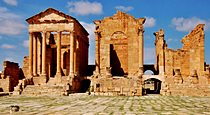
Battle of Sufetula |
year: 647 |
| Byzantine defeat and destruction of the city of Sufetula | ★ ★ ★ ★ ★ |
|
enemy: Arabs (Umayyads)
|
location: City of Sufetula (or Sbeitla, modern Subayṭilah) in north central Tunisia 33km NE of Kasserine
|
accuracy:
●●●●●
|
|
battle type: City Capture |
war: Muslim Conquest of North Africa |
modern country:
Tunisia |
| ▼ The Byzantines(emperor: Constans II Pogonatos) | ▼ The Enemies | |
| Commander: | Exarch Gregory the Patrician | Governor of Egypt Abdallah ibn Sa’ad |
| Forces: | 40,000 | |
| Losses: |
| Background story: |
| Emperor Maurice sometime between 585 and 590 established two exarchates, one of which was the Exarchate of Africa based at Carthage and including all imperial possessions in Africa, west of Cyrenaica. Towards the end of the first phase of the Arabian conquests, in 642–643, the Arabs had seized Cyrenaica and the eastern half of Tripolitania, along with Tripoli. It was only an order from Caliph Umar that halted their westward expansion postponing the capture of Carthage. But the danger of an Arab attack was imminent. Moreover, the Exarchate of Africa was in internal turmoil due to the conflict between the mainly Orthodox Chalcedonian population and the supporters of Monotheletism. In 646, the exarch Gregory the Patrician rebelled against Emperor Constans II. The pretext was the emperor’s tolerance towards Monotheletism, but, in fact, Gregory wanted to take advantage of the power void and the chaos that ensued the Arabian conquest. The revolt seems to have found broad support among the populace as well, not only among the Romanized Africans, but also among the Berbers of the interior. In 647, Umar’s successor Uthman allowed the new governor of Egypt Abdallah ibn Sa’ad to invade the Exarchate. |
The Battle: |
 Ruins of Sufutela today Gregory confronted the Arabs at Sufetula. The city was one of the most important cities of the exarchate at the time. Gregory was defeated and killed. Some sources claim that he survived the defeat and fled to Constantinople, where he was reconciled with Constans, but most modern scholars accept the Arab chroniclers’ account of his death in battle. The Arab accounts also claim that the Muslims captured Gregory's daughter, who had fought at her father’s side. She was carried along back to Egypt as part of the booty, but she fell from her camel on the march and was killed. After Gregory's death, the Arabs sacked Sufetula and raided across the Exarchate, while the Byzantines withdrew to their fortresses. Unable to storm the Byzantine fortifications, and satisfied with the huge amounts of plunder they had made, the Arabs agreed to depart in exchange for the payment of a heavy tribute in gold by the successor of Gregory, Gennadius. The campaign of the Arabs against the Byzantine territories had lasted 15 months. At the end the Arab forces returned back to Egypt in 648. |
Aftermath: |
| Sufetula was destroyed and laid in ruins there after. Africa returned to imperial allegiance after Gregory’s death and the Arabs’ withdrawal, but in reality the province had been capitulated and for the next 50 years it behaved like a vassal state to the Arabs. |
|
|
